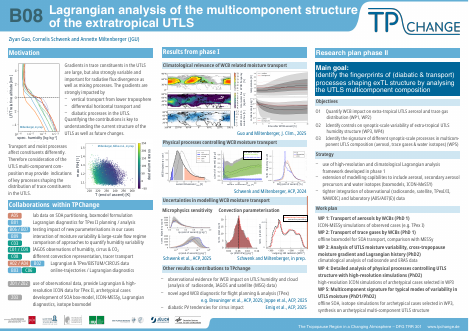
Project B08:
Lagrangian analysis of moisture, aerosols, trace gases and water isotope distribution in the extra-tropical UTLS
Brief Summary
Radiatively active substances, including water vapor, clouds, aerosols, and trace gases, in the UTLS region are known to substantially influence the current climate state and future changes thereof. In Phase I, we have focused on water vapor transport to the UTLS in warm-conveyor belts (WCB): we have for the first time quantified the contribution of WCB to the extra-tropical UTLS based on ERA5 reanalysis data as well as developed and applied diagnostics for water-vapor transport in WCBs including the role of embedded convection. Furthermore, we have investigated the role of cirrus in the extra-tropical transition layer in shaping the UTLS thermodynamics structure.
Recent analysis of the TPex measurements and other observational datasets show a large variability of UTLS aerosol and moisture structure at annual, seasonal, and synoptic timescale. The processes and flow configurations controlling the emergence of these structures is only partially understood.
In Phase II, we will therefore
(i) systematically quantify the variability of UTLS moisture structure,
(ii) investigate the processes that result in the different UTLS moisture structures, and
(iii) expand our diagnostics from Phase I to other trace constituents, in particular aerosols and water isotopes.
The variability of UTLS moisture structure will be quantified by analyzing existing observational data, in particular high-resolution radiosonde data, with advanced statistical methods. On this basis we will select archetypical scenarios (also considering availability of detailed observational data from TPex-I/II, NAWDIC), which will then be investigated in detail with high-resolution ICON simulations including our Lagrangian diagnostics. Further, starting with a WCB scenario, we will investigate the role of vertical transport for UTLS aerosol composition by utilizing ICON-MESSY aerosol and chemistry modules. In addition, we will explore potential signatures in water isotopes with offline box-model simulations along our high-resolution ICON-based trajectories. Aerosol and water isotope signatures will be compared to observational data from airborne platforms (e.g. TPex-I/II, NAWDIC) and satellite, where possible.
By considering the combination of different trace constituents we may identify fingerprints of different processes and air mass sources that can be used to more vigorously combine observations and models and provide effective, processes-oriented evaluation options for the models.
Project Poster
Evaluation Poster Phase I in 2025
Members

Jun.-Prof. Dr. Annette Miltenberger
Principal Investigator
Johannes Gutenberg-Universität Mainz, Institut für Physik der Atmosphäre
amiltenb[at]uni-mainz.de

Former Member Phase I:
Guo Ziyan
Doctoral Candidate
Johannes Gutenberg-Universität Mainz, Institut für Physik der Atmosphäre

Former Member Phase I:
Cornelis Schwenk
Doctoral Candidate
Johannes Gutenberg-Universität Mainz, Institut für Physik der Atmosphäre
Publications
Breuninger, A., P. Joppe, J. Wilsch, C. Schwenk, H. Bozem, N. Emig, L. Merkel, R. Rossberg, T. Keber, A. Kutschka, P. Waleska, S. Hofmann, S. Richter, F. Ungeheuer, K. Dörholt, T. Hoffmann, A. Miltenberger, J. Schneider, P. Hoor, and A. L. Vogel (2025): Organic aerosols mixing across the tropopause and its implication for anthropogenic pollution of the UTLS. Atmospheric Chemistry and Physics 25 (22), 16533–16551. doi: 10.5194/acp-25-16533-2025.
Emig, N., A. K. Miltenberger, P. M. Hoor, and A. Petzold (2025): Impact of cirrus on extratropical tropopause structure. Atmospheric Chemistry and Physics 25 (20), 13077–13101. doi: 10.5194/acp-25-13077-2025.
Guo, Z. and A. Miltenberger (2025): Climatology of warm conveyor belt contributions to UTLS moisture in ERA5 between 2010 and 2019. Journal of Climate, doi: 10.1175/JCLI-D-25-0020.1
Joppe, P., J. Schneider, J. Wilsch, H. Bozem, A. Breuninger, J. Curtius, M. Ebert, N. Emig, P. Hoor, S. Ismayil, K. Kandler, D. Kunkel, I. Kurth, H.-C. Lachnitt, Y. Li, A. Miltenberger, S. Richter, C. Rolf, L. Schneider, C. Schwenk, N. Spelten, A. L. Vogel, Y. Cheng, and S. Borrmann (2025): Transport of Biomass Burning Aerosol into the Extratropical Tropopause Region over Europe via Warm Conveyor Belt Uplift. Atmospheric Chemistry and Physics 25 (21), 15077–15103. doi: 10.5194/acp-25-15077-2025.
Lüttmer, T., A. Miltenberger, and P. Spichtinger (2025): On the impact of ice formation processes and sedimentation on cirrus origin classification in warm conveyor belt outflow. Atmospheric Chemistry and Physics 25 (17), 10245–10265. doi: 10.5194/acp-25-10245-2025.
Schwenk, C., A. Miltenberger, and A. Oertel (2025): Microphysical parameter choices modulate ice content and relative humidity in the outflow of a warm conveyor belt. Atmospheric Chemistry and Physics 25 (18), 11333–11361. doi: 10.5194/acp-25-11333-2025.
Schwenk, C. and A. Miltenberger (2024): The role of ascent timescales for warm conveyor belt (WCB) moisture transport into the upper troposphere and lower stratosphere (UTLS). Atmospheric Chemistry and Physics 24 (24), 14073–14099. doi: 10.5194/acp-24-14073-2024.

